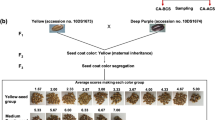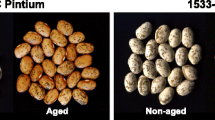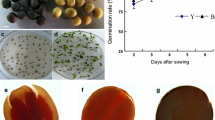Abstract
Visual quality is one of the major factors determining the market value of field pea (Pisum sativum L.). Breeding for improved visual quality of pea seeds is currently a challenging task, mainly because of the complexity and the lack of sound genetic knowledge of the traits. The objectives of this research were to characterize post-harvest cotyledon bleaching resistance in green pea at the biochemical and gene expression levels. Seed coats and cotyledons of two pea cultivars, CDC Striker (bleaching resistant) and Orb (bleaching susceptible) at three developmental stages [14, 21 and 28 days after flowering (DAF)] and following exposure to accelerated bleaching conditions after harvest (0, 3, 6, and 13 days after bleaching (DAB) were evaluated. CDC Striker had a slower rate of chlorophyll degradation in cotyledons, and a higher total carotenoids to chlorophyll ratio in seed coats, than Orb when seed samples were exposed to high intensity light. An oligo-nucleotide microarray (Ps6kOLI1) revealed that gene expression profiles of the CDC Striker and Orb seed coats were significantly different during seed developmental stages. A significant up regulation of genes involved in the production and accumulation of secondary metabolites responsible for antioxidant properties including epiafzelechin, epicatechin, epigallocatechin, kaempferide, kaempferol 3-O-β-d-sophorotrioside, O-quercetin and rutin, in the seed coats of CDC Striker were observed. Thus, bleaching resistance in field pea could be due to the accumulation of specific carotenoids and phenolic compounds which quench excess light or scavenge free radical singlet oxygen molecules. The candidate genes identified in this project will need to be validated using qPCR to further support their involvement with bleaching resistance before being used for the development of gene specific markers.





Similar content being viewed by others
References
Anderson IC, Robertson DS (1960) Role of carotenoids in protecting chlorophyll from photodestruction. Plant Physiol 35:531
Aro EM, Virgin I, Andersson B (1993) Photoinhibition of photosystem II. Inactivation, protein damage and turnover. Biochim Biophys Acta 1143:113
Artus NN, Somerville SC, Somerville CR (1986) The biochemistry and cell biology of photorespiration. CRC Crit Rev Plant Sci 4:121
Asada K (1999) The water–water cycle. Annu Rev Plant Physiol Plant Mol Biol 50:601
Bassuner R, Baumlein H, Huth A, Jung R, Wobus U, Rapoport TA, Saalbach G, Muntz K (1998) Abundant embryonic mRNA in field bean (Vicia faba L.) codes for a new class of seed proteins: cDNA cloning and characterization of the primary translation product. Plant Mol Biol 11:321–334
Batchelor AK, Boutilier K, Miller SS, Hattori J, Bowman LA, Hu M, Lantin S, Johnson DA, Miki BL (2002) SCB1, a BURP-domain protein gene, from developing soybean seed coats. Planta 215:523–532
Calucci L, Capocchi A, Galleschi L, Ghiringhelli S, Pinzino C, Saviozzi F, Zandomeneghi M (2004) Antioxidants, free radicals, storage proteins, puroindolines, and proteolytic activities in bread wheat (Triticum aestivum) seeds during accelerated aging. J Agric Food Chem 52(13):4274–4281
Canadian Grain Commission (2008) Official Grain Grading Guide. 1 August 2008. Canadian Grain Commission, Winnipeg, Man. p. 343–360
Cheng M, McPhee KE, Baik B-K (2004) Bleaching of green peas and changes in enzyme activities of seeds under simulated climatic conditions. J Food Sci 69(7):511–518
Chesnokov Y, Meister A, Manteuffel R (2002) A chimeric green fluorescent protein gene as an embryonic marker in transgenic cell culture of Nicotiana plumbaginifolia V iv. Plant Sci 162:59–77
de Lourdes Mata Bilbao M, Andrés-Lacueva C, Jáuregui O, Lamuela-Raventós RM (2007) Determination of flavonoids in a citrus fruit extract by LC-DAD and LC-MS. Food Chem 101(4):1742–1747
Demmig-Adams B (1990) Carotenoids and photoprotection in plants: a role for the xanthophyll zeaxanthin. Biochim Biophys Acta 1020:1–24
Demmig-Adams B, Adams WW, Barker DH, Logan BA, Bowling DR, Verhoeven AS (1996) Using chlorophyll fluorescence to assess the fraction of absorbed light allocated to thermal dissipation of excess excitation. Physiol Plant 98:253
Dondrup M, Goesmann A, Bartels D, Kalinowski J, Krause L, Linke B, Rupp O, Sczyrba A, Pühler A, Meyer F (2003) EMMA: a platform for consistent storage and efficient analysis of microarray data. J Biotech 106(2–3):135–146
Dribnenki PC (1979) A study of bleaching resistance in green cotyledon, dry edible peas., M. Sc. Thesis, University of Saskatchewan
Dueñas M, Hernández T, Estrella I (2002) Phenolic composition of the cotyledon and the seed coat of lentils (Lens culinaris L.). Eur Food Res Technol 215(6):478–483
Dueñas M, Sun B, Hernández T, Estrella I, Isabel SM (2003) Proanthocyanidin composition in the seed coat of lentils (Lens culinaris L.). J Agric Food Chem 51(27):7999–8004
Dueñas M, Hernández T, Estrella I (2006) Assessment of in vitro antioxidant capacity of the seed coat and the cotyledon of legumes in relation to their phenolic contents. Food Chem 98(1):95–103
Dueñas M, Hernández T, Estrella I (2007) Influence of the action of exogenous enzymes on the polyphenolic composition of pea: effect on the antioxidant activity. Eur Food Res Technol 225(3):493–500
Foyer CH, Descourvires P, Kunert KJ (1994a) Protection against oxygen radicals: an important defense mechanism studied in transgenic plants. Plant Cell Environ 17:507
Foyer CH, Lelandais M, Kunert KJ (1994b) Photooxidative stress in plants. Physiol Plant 92:696
Ganeshan S, Drinkwater JM, Repellin A, Chibbar RN (2010) Selected carbohydrate metabolism genes show coincident expression peaks in grains of in vitro-cultured immature spikes of wheat (Triticum aestivum L.). J Agric Food Chem 58(7):4193–4201
Gross J (1991) Pigments in vegetables: Chlorophylls and carotenoids. AVI Books, New York
Gubbels GH, Ali-Khan ST (1990) Screening green field pea genotypes for resistance to color loss. Can J Plant Sci 70:45–50
Gurevitch J, Chester JST (1986) Analysis of repeated measures experiments. Ecology 67(1):251–255
Hajimehdipoor H, Kondori BM, Amin GR, Adib N, Rastegar H, Shekarchi M (2012) Development of a validated HPLC method for the simultaneous determination of flavonoids in Cuscuta chinensis Lam. by ultra-violet detection. Daru 20(1):57
Harborne JB, Marby TJ, Mabry H (1975) The flavonoids. Chapman and Hall, London
Havaux M (1998) Carotenoids as membrane stabilizers in chloroplasts. Trends Plant Sci 3:147
Havaux M, Gruszecki WI, Dupont I, Leblanc RM (1991) Increased heat emission and its relationship to the xanthophyll cycle in pea leaves exposed to strong light stress. J Photochem Photobio B 8(4):361–370
Ibrahim A-R, Abul-Hajj YJ (1990) Microbiological transformation of (1) flavanone and (±) isoflavanone. J Nat Prod 53(3):644–656
Küster H, Dondrupup M (2006) Integration of gene expression profiling in European projects on legumes. Grain Legumes 46:14–15
Lamprecht H (1959) The inheritance of colors of a seeds of Pisum. Agri Hort Genet Landskrona 17:1–18
Lichtenthaler HK (ed) (1987) Chlorophylls and carotenoids: pigments of photosynthetic biomembranes. Academic Press, San Diego
Loria R, Lacy ML (1979) Mechanism of increased susceptibility of bleached pea seeds to seed and seedling rot (Fusarium solani pisi). Phytopathology 69(6):573–575
Maguire JD, Kropf JP, Steen KM (1973) Pea seed viability in relation to bleaching. Proc Assoc Off Seed Anal 63:51–58
Malikov VM, Yuldashev MP (2002) Phenolic compounds of plants of the Scutellaria genus. Distribution, structure, and properties. Chem Nat Compd 38(5):473–519
McCallum J, Timmerman-Vaughan G, Frew T, Russell A (1997) Biochemical and genetic linkage analysis of green seed color in field pea. J Am Soc Hortic Sci 122(2):218–225
Mehler AH (1951) Studies on reactions of illuminated chloroplasts. I. Mechanism of the reduction of oxygen and other Hill reagents. Arch Biochem Biophys 33:65
Morishita T, Hajika M, Sakai S, Tetsuka T (1995) Development of a simple spectrophotometric assay for the rutin-degrading enzyme in buckwheat. Curr Adv Buckwheat Res. 833–837
Mullin WJ, Xu W (2001) Study of soybean seed coat components and their relationship to water absorption. J Agric Food Chem 49(11):5331–5335
Niyogi KK (1999) Photoprotection revisited: genetic and molecular approaches. Annu Rev Plant Phys 50(1):333–359
Pinzino C, Capocchi A, Galleschi L, Saviozzi F, Nanni B, Zandomeneghi M (1999) Aging, free radicals, and antioxidants in wheat seeds. J Agric Food Chem 47(4):1333–1339
Polle A (1997) Defense against photooxidative damage in plants. Press New York, In Oxidative Stress and the Molecular Biology of Antioxidant Defenses. Edited by J.G. Scandalios. Cold Spring Harbor Lab
Radchuk R, Radchuk V, Weschke W, Borisjuk L, Weber H (2006) Repressing the expression of the sucrose nonfermenting-1-related protein kinase gene in pea embryo causes pleiotropic defects of maturation similar to an abscisic acid-insensitive phenotype. Plant Physiol 140(1):263–278
Riehle WG, Muelbauer FJ (1975) Laboratory technique for bleaching pea seeds. Crop Sci 15(6):853–855
Roszak AW, McKendrick K, Gardiner AT, Mitchell IA, Isaacs NW, Cogdell RJ, Hashimoto H, Frank HA (2004) Protein regulation of carotenoid binding: gatekeeper and locking amino acid residues in reaction centers of Rhodobacter sphaeroides. Structure 12(5):765–773
Rowell JG, Walters DE (1976) Analyzing data with repeated observations on each experimental unit. J Agric Sci 87:423–432
Sambrook J, Russel DW (2001) Molecular Cloning, Volume 3, 3rd edn. Cold Spring Harbor Laboratory Press, Cold Spring Harbor
Sandmann G, Kuhn M, Böger P (1993) Carotenoids in photosynthesis: protection of D1 degradation in the light. Phot Synth Res 35(2):185–190
Shepherd AD (1959) Effect of illumination on color of frozen peas packaged in a transparent film. Food Technol 9:539–540
Sims DA, Gamon JA (2002) Relationships between leaf pigment content and spectral reflectance across a wide range of species, leaf structures and developmental stages. Remote Sens Environ 81(2–3):337–354
Singh R, Wu B, Tang L, Zhongqiu Liu Z, Hu M (2010) Identification of the position of mono-O-glucuronide of flavones and flavonols by analyzing shift in online UV Spectrum (λmax) generated from an online diode-array detector. J Agric Food Chem 58(17):9384–9395
Son LV, Tiedemann J, Rutten T, Hiller S, Hinz G, Zank T, Manteuffel R, Baumlein H (2009) The BURP domain protein AtUSPL1 of Arabidopsis thaliana is destined to the protein storage vacuoles and over expression of the cognate gene distorts seed development. Plant Mol Biol 71:319–329
Steiger S, Schäfer L, Sandmann G (1999) High-light-dependent up-regulation of carotenoids and their antioxidative properties in the Syanobacterium synechocystis PCC 6803. J Photochem Photobio B 52(1–3):14–18
Ubayasena L, Bett K, Tar’an B, Perumal V, Warkentin T (2010) Genetic control and QTL analysis of cotyledon bleaching resistance in green field pea (Pisum sativum L.). Genome 53(5):346–359
Wang A, Xia Q, Xie W, Datla R, Selvaraj G (2003) The classical Ubisch bodies carry a sporophytically produced structural protein (PAFTIN) that is essential for pollen development. Proc Natl Acad Sci USA 100:14487–14492
Warkentin T, Vandenberg A, Banniza S, Slinkard A (2004) CDC Striker field pea. Can J Plant Sci 84:239–240
Watson CF, Zheng L, DellaPenna D (1994) Reduction of tomato polygalacturonase beta subunit expression affects pectin solubilization and degradation during fruit ripening. Plant Cell 6:1623–1634
Weigelt K, Küster H, Radchuk R, Muller M, Weichert H, Fait A, Fernie AR, Saalbach S, Weber W (2008) Increasing amino acid supply in pea embryos reveals specific interactions of N and C metabolism, and highlights the importance of mitochondrial metabolism. Plant J 55(6):909–926
Zheng L, Heupel RC, DellaPenna D (1992) The beta subunit of tomato fruit polygalacturonase isoenzyme 1: isolation, characterization, and identification of unique structural features. Plant Cell 4:1147–1156
Zheng L, Watson CF, DellaPenna D (1994) Differential expression of the two subunits of tomato polygalacturonase isoenzyme 1 in wild-type rin tomato fruit. Plant Physiol 105:1189–1195
Acknowledgments
Funding for this research Project was provided by the Saskatchean Pulse Growers Association and the Agricultural Development Fund of the Saskatchewan Ministry of Agriculture. Technical support provided by Brent Barlow, Kari-Lynne McGowan and Amila Heendeniya, and the staff of the University of Saskatchewan Pulse Research Laboratory are greatly appreciated. Authors would also like to thanks Dr. Vikrum Misra and Norin Rapin, Western College of Veterinary Medicine, University of Saskatchewan for providing the microarray imaging facilities.
Author information
Authors and Affiliations
Corresponding author
Electronic supplementary material
Below is the link to the electronic supplementary material.
10681_2013_914_MOESM1_ESM.ppt
Differential gene expression pattern within the porphyrin and chlorophyll biosynthesis pathway of seed coats of CDC Striker and Orb at 14, 21 and 28 DAF. Yellow boxes indicate that the gene expression responsible for a particular step is significantly different (P ≤ 0.05) between cultivars and the responsible gene ID is given as PSOLI number. Refer to Table 5 for gene annotation. Green (CDC Striker up regulated) and red (Orb up regulated) histograms represent the transcript profiling at 14, 21 and 28 DAF. (PPT 217 kb)
10681_2013_914_MOESM2_ESM.ppt
Differential gene expression pattern within the carotenoid biosynthesis pathway of the seed coats of CDC Striker and Orb at 14, 21 and 28 DAF. Yellow boxes indicate that the gene expression responsible for a particular step is significantly different (P ≤ 0.05) between cultivars and the responsible gene ID is given as PSOLI number. Refer to Table 5 for gene annotation. Green (CDC Striker up regulated) and red (Orb up regulated) histograms represent the transcript profiling at 14, 21 and 28 DAF. (PPT 211 kb)
10681_2013_914_MOESM3_ESM.ppt
Differential gene expression pattern within the phenylpropanoid biosynthesis pathway of seed coats of CDC Striker and Orb at 14, 21 and 28 DAF. Yellow boxes indicate that the gene expression responsible for a particular step is significantly different (P ≤ 0.05) between cultivars and the responsible gene ID is given as PSOLI number. Refer to Table 5 for gene annotation. Green (CDC Striker up regulated) and red (Orb up regulated) histograms represent the transcript profiling at 14, 21 and 28 DAF. (PPT 180 kb)
10681_2013_914_MOESM4_ESM.ppt
Differential gene expression pattern within the flavonoid biosynthesis pathway of seed coats of CDC Striker and Orb at 14, 21 and 28 DAF. Yellow boxes indicate that the gene expression responsible for a particular step is significantly different (P ≤ 0.05) between cultivars and the responsible gene ID is given as PSOLI number. Refer to Table 5 for gene annotation. Green (CDC Striker up regulated) and red (Orb up regulated) histograms represent the transcript profiling at 14, 21 and 28 DAF. (PPT 198 kb)
10681_2013_914_MOESM5_ESM.ppt
Differential gene expression pattern within the flavone and flavonol biosynthesis pathway of seed coats of CDC Striker and Orb at 14, 21 and 28 DAF. Yellow boxes indicate that the gene expression responsible for a particular step is significantly different (P ≤ 0.05) between cultivars and the responsible gene ID is given as PSOLI number. Refer to Table 5 for gene annotation. Green (CDC Striker up regulated) and red (Orb up regulated) histograms represent the transcript profiling at 14, 21 and 28 DAF. (PPT 155 kb)
Rights and permissions
About this article
Cite this article
Ubayasena, L., Vijayan, P., Bett, K.E. et al. Gene expression profiles of seed coats and biochemical properties of seed coats and cotyledons of two field pea (Pisum sativum) cultivars contrasting in green cotyledon bleaching resistance. Euphytica 193, 49–65 (2013). https://doi.org/10.1007/s10681-013-0914-2
Received:
Accepted:
Published:
Issue Date:
DOI: https://doi.org/10.1007/s10681-013-0914-2




